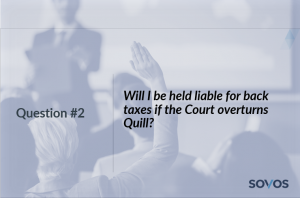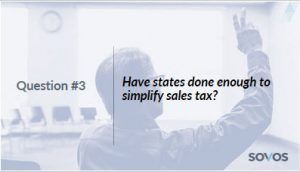This blog was last updated on March 11, 2019
Since oral arguments have been heard by the Supreme Court in South Dakota vs. Wayfair, Sovos has been approached by tax professionals, clients and media members for insights into what happens next and what changes may be in store for eCommerce retailers and anyone selling direct to consumers. Yes, even manufacturing companies may be affected by this summer’s court decision.
A recap of our webinar, “South Dakota vs. Wayfair and What it Means for eCommerce,” with Sovos regulatory expert, Chuck Maniace, is below. If you asked a question we were unable to get to, subscribe to the blog as we will be answering them in our next post.

Question 1: So…what happens next?
Chuck Maniace (CM):
1. The Supreme Court meets in what’s called the Justices conference, where each Justice is allowed uninterrupted time to express their opinion about the case and how it should be decided.
2. They’ll then take a vote to essentially determine who’s won the case.
3. Once there is a clear majority, meaning five or more Justices agree as to who should win the case, the senior-most Justice will decide who writes the majority opinion.
The first 3 steps have likely already happened.
4. Over the next couple of weeks, that Justice and their law clerks will write the opinion.
5. Then the other Justices who signaled they would also be of that same opinion will officially sign on. Of course, other Justices have the ability to write their own separate opinions, and those Justices that disagree can write a dissenting opinion. But when push comes to shove, what’s really important is what that majority opinion says.

Question 2: Will I be held liable for back taxes if the Court overturns Quill?
CM: The South Dakota Department of Revenue indicated 38 states have already signaled they would not dream of doing anything that would extract tax revenue for transactions that have happened far in the past.
Now, the attorneys for Wayfair and their colleagues said there is a reason to be wary of retroactive assessments. They point to one letter written by a Connecticut Department of Revenue official that suggested to a specific taxpayer that they are actually liable for back taxes.
What’s really more important to understand here is there are a number of states that have created rules contingent upon this case being decided. Whether or not retroactive liability is a concern, there is an immediate concern for prospective liability. Stated another way, a lot of states are ready, or have already changed their laws to tax remote commerce immediately if the Court opts to overturn Quill.

Question 3: Have states done enough to simplify sales tax?
CM: While the Justices looked at the South Dakota law, they were really far more concerned about what would happen in the rest of the country should they opt to overturn Quill. There were strong arguments on both sides. The South Dakota Department of Revenue pointed very clearly to the 24 states that have joined the Streamlined Sales Tax Project (SSTP). Over the past 15 years, the members states of SST have created a simplified taxpayer registration process, a very simplified tax return, published boundary files and rate files so sellers know what tax to collect, and provided very clear and uniform tax matrices so sellers know what’s taxable and what’s not taxable in each state.
There has been a lot of work to simplify sales tax since that 1992 Quill case. But the Wayfair folks would point to the fact that the SSTP includes only 24 states. The rest of the country (states like New York, California, and Pennsylvania) are not part of SSTP. There’s an argument to be made that the rest of the country hasn’t really thought about or changed their laws to facilitate national sales tax compliance, that states haven’t made things as simple as they could be – in a way that enables far-flung companies from across the country, maybe across the world, to reasonably comply with their tax rules.

Question 4: What about small sellers?
CM: It’s interesting to think about this question in the framework of South Dakota’s law. What South Dakota said in their statute was that any seller who has 200 sales into the state or has $100,000 in transactions to South Dakota customers would be liable to collect and remit their sales tax.
Compare that to the Marketplace Fairness Bill. That standard was quite different in that it looked to national sales and excluded any business with annual gross receipts (for all the US) of $1,000,000 or less.
The question of small sellers and promoting fair competition prompted a lot of debate amongst the Justices about what types of rules would truly serve this purpose. Do we need to be concerned about protecting small businesses from complex, and insurmountable tax rules? Or does protecting them mean that we’re enacting laws that put everybody on the same playing field with respect to tax compliance? Meaning a small Internet seller, selling around the country collects tax in the same way as their brick and mortar competitor in that same state?
There wasn’t a clear answer – but certainly, the view of what best serves small sellers and promotes fair competition is something that’s going to weigh on the minds of the Justices as they make their decision.

Question 5: What role will software play?
CM: One thing the Court was frustrated with is that both sides presented very different representations of reality. Part of this frustration stemmed from a lack of understanding around software solutions. South Dakota was quick to point out that software can be as cheap as $12 a month for a limited number of transactions, but Wayfair countered by explaining that this is not always the case and that software implementation costs can be substantial and that audit defense isn’t always supported by software applications and has its own set of costs.
The bottom line: Both sides may have been a little too simplistic in their approach. The reality is that software is indeed available and affordable, with solutions scalable depending on the nature of the seller, how they sell across the country, how many different types of products they offer, and how complex their transactions are.
The Justices will wrestle with this question and if some feel they don’t have enough information to make a choice, it could definitely influence what they decide.

Question 6: What should eCommerce businesses be doing right now?
CM: Several justices saw their options as “binary” meaning they could do only one of two things:
1. Completely overturning Quill and creating a rule that says any sale in any state creates an obligation to collect and remit tax. This would potentially allow states to enact rules that are even more expansive than South Dakota’s. It could be one sale and $1 of revenue that creates nexus, rather than 200 sales with $100,000 of revenue.
2. Leaving Quill as the law of the land and maintaining the same physical presence standard that has prevailed for decades.
Regardless, eCommerce businesses will be faced with a new reality come June. Either they’ll have an expanded obligation under a standard different from Quill, or states (faced with the continuing viability of Quill) will double down on all the things they’ve done to date to try to nibble at the fringes of the doctrine and try to get as many eCommerce sellers collecting their tax as humanly possible. States will enact things like notice requirements (similar to Colorado) or Cookie Nexus (similar to Massachusetts), and really try to get as much eCommerce subject to tax as possible.
Take Stock of What You Sell, Where You Sell It, and How You Sell It
eCommerce businesses should really take time to take stock of what they sell, where they sell it, and how they sell it. That sounds simple, but when you start dealing with multichannel retailers or manufacturers, that answer isn’t necessarily as easy as you would think. Having that answer in the back of your mind allows you to evaluate what you would need to do if Quill is overturned, and how you should consider your liability should a state enact a cookie rule like Massachusetts, or taxpayer notice provision like Colorado.
Will My Technology Enable Scalable Compliance?
The other thing to keep in mind is, “do I have technology in place that would enable me to scale with ease where I’m collecting tax?” The benefit of a third party tax technology solution that it enables you to set it up for based on your current tax liability footprint, but should that footprint expand based on either an overturning of Quill, or a state enacting a rule that tries to work within the framework of Quill to make you subject to tax, you can simply click a couple of buttons and start to collect tax in those new states as well.
How Will We Handle Audits?
The other thing to think about is, “how am I going to handle audits?” Do you have functionality in place that enables you to extract transactional data and share it with a state regulator in a coherent and readily understood format in the event of a sales tax audit? Or is a sales tax audit going to mean a ton of hours of extra work?

Question 7: When will we know what happens next?
CM: The Supreme Court, now that they’ve heard the case, has to make a decision. That usually will happen towards the end of their term, most likely in June. The minute the opinion is announced and published, every sales tax expert in the country will be downloading (and printing) it, reading the last page first, and figuring out what it means in the sales tax world going forward.
Take Action
Visit our Intelligent Compliance Blog and resource center to subscribe to weekly updates, and be among the first to RSVP to our Chuck Live SD v Wayfair Decision webinar immediately following the final Supreme Court ruling!
Ready to learn how Sovos can safeguard you from constant regulatory and business change? Contact Us.